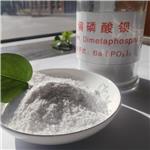Uses
Barium metaphosphate, used in glasses, porcelains, and enamels, as a flame retardant and in phosphors applications.
Preparation
Barium metaphosphate can be prepared by the solidstate
reaction of metaphosphoric acid and the
hydroxide, oxide or carbonate of barium:
BaCO3 + HPO3 + heat ? Ba(PO3)2 +H2O + CO2
The best temperature to use is about 700°C. It has the
CAS number of 13762-83-9 and the molecular weight of
295.2709 g/mol. If diammonium phosphate is used
instead of solid metaphosphoric acid, the product is
not pure. Colored glasses are obtained caused by the
reduction of P-atoms in the phosphate anion by
hydrogen released from NH3 to form colloidal dispersions
of P4 which produce various colors in the glass.
b-Ba(PO3)2 is the final product. This compound can
also be prepared by the aqueous reactions:
NaPO3 (aq) + BaCl2 (aq) ? Ba(PO3)2 (solid) + NaCl (aq)
or
Ba(OH)2 (solid) + 2HPO3 (aq) ? Ba(PO3)2 (solid)
+ 2H2O
The dissolution and reaction involving HPO3 are
slow and should be carried out in a hot solution. Evaporation
at a low temperature (<15°C) serves to form the
crystals. The product involves several hydrates depending
upon the conditions of precipitation. Anhydrous
barium metaphosphate is a white porous powder or
granular material that is insoluble in water.




